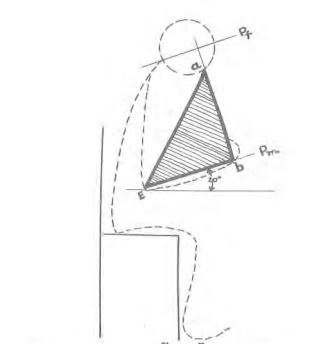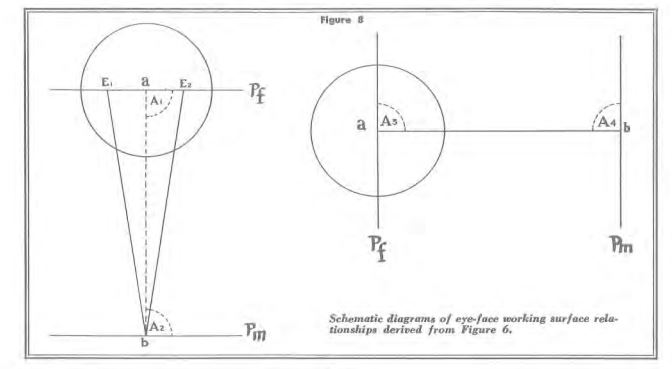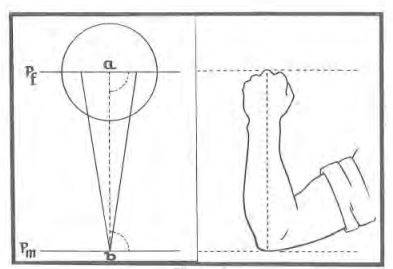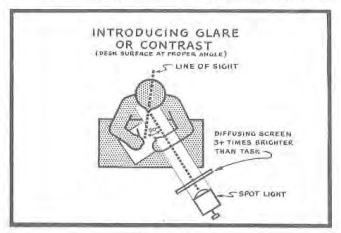Vision Hygiene
Posture
Excerpt from The COORDINATED CLASSROOM
By Darell Boyd Harmon

Figure 7
Schematic projection onto medial plane of the trunk of balanced
postural relationships for close, sustained, visuallycentered
tasks.
By means of these reflex movements, the subject reaches a posture for close visual activity where the mid-point between the eyes, the point of each elbow (the olecranon), and the knuckle of each middle finger, roughly describe an equilateral triangle with its base inclined upward from the elbow out of the horizontal by approximately 20°. The base of this triangle extends from the olecranon forward of the trunk and inward to meet a forward projection of the medial plane of the trunk. When the equilateral triangle described by the middle knuckle, the point of the elbow, and the midpoint between the eyes is projected onto a forward extension of the medial plane of the head and trunk (the plane described above) , as shown in the diagram, Figure 7, the shape of this projection on this medial plane approaches a right triangle. The lower angle of this triangle points towards the center of gravity of the body when seated, and the perpendicular leg becomes the line of sight from the point between the two eyes to the point of fixation. The base of the triangle is tilted upward at approximately the 20° angle that follows the upward slope of the forearms. The photographs and drawings in Figure 6 present a front and side view of a child's reflexly assumed posture when engaged in close visually-centered activity. The line "Pf" in these figures represents the plane of the face, while the line "Pm" represents the plane of the materials on which the child is fixating, such as a book or sheet of paper for writing. Line "Pm" represents the same plane, 20° out of the horizontal, that is established by the forearms when they reach a position parallel with the plane of the face. Point "a" is the mid-point between the two eyes, and point "b" is the point of fixation (the point at which the child is looking). These diagrams are repeated, schematically, in Figure 8 for simplification.

The line "ab" establishes the upper and forward
leg or edge of both the equilateral triangles formed
by the mid-point of the eyes, the elbows, and the middle
finger joint of each hand. For convenience hereafter,
line "ab" will be called "the line of sight".

Figure 9
Method of determining working distance from intra pupillary
point to point of fixation in close visually-centered activity.
Points "E1" and "E2" in the horizontal drawing of
the child represent the points where the frontal plane
of the face intersects the two eyes. Notice that lines
"Pf" and "Pm" are, parallel in both views, and that
the line of sight (line "ab") is perpendicular to both
these lines or planes in each of these views. The
angles marked Al and A2 in the side view, and A3
and A4 in the horizontal view all approach right
angles.
The position of the child's body represented in these
three drawings is the starting position for close
visually-centered activity. This is also the position to
which the sight-related reflexes attempt to return the
head, trunk, and arms all the time close visuallycentered
activity is going on. Any other adjustive
movements or other postures assumed during the
course of the performance of the task (other than
those for relieving normal fatigue) represent. s.tresses
or energy expenditures lover and above those entering
into this basic posture.
The data showed that the visually dominated bodybalancing
and sighting reflexes operate to maintain
the relations shown in these schematic drawings at as
near oonstants as interfering factors in the environment
will permit (such as interfering light, poorly
fitted desks, etc.). These posture constants for efficient
visual tasks were defined as follows 6 :
1. When free of restraint the plane of the face
(Pf) in sustained tasks, at all times approaches a parallel
relationship with the plane of the materials
(Pm). The function of this action is to keep both
eyes at as near the same distance from the work as
possible, in order that both areas of retinal stimulation
will be as near alike as binocular vision requires
to produce a fused, single perceived image, and
to provide that visual co-ordinates and postural coordinates
approach each other as closely as possible.
2. The line of sight (ab) lies on a forward projection
of the medial plane of the head (a plane extending
from back to front through the head at the midline).
If the child's fixation is only momentary, the
line of sight is perpendicular only to the plane of the
face. If the visual task is sustained, the head and
trunk are reflexly adjusted (to reduce energy expenditure
) so as to bring the mid-line or medial plane of
the face into continuum with the mid-line or medial
plane of the trunk. The line of sight then lies on a
forward projection of a plane intersecting both the
head and the trunk at their mid-line.
3. The line of sight (as measured from the midpoint
,between the eyes to the point of fixation ) will
be maintained at a length approximating the distance
from the center of the third joint of the middle finger
(middle knuckle) to the center of the elbow, when
measured on the outside of the arm (the posterior
linear measurement from the olecranon to the middle
metacarpal) . This measurement is shown in Figure
9. This is the distance from the eyes at which the two
hands can work with them at the greatest efficiency. In
some 40,000 measurements of subjects with normal
vision, with few exceptions, the difference between this

Figure 14
Method of setting up experiment shown in Figures 12 and 13.
measurement and measurements of the actual line of
sight was not found to be over -+- 3 centimeters.
(-+- 1.181 inches).
4. Within certain limits, the line running between
the two eyes (E1E2) on the plane of the face, and
lines projected from the two eyes to the point offixation
(El b, and E2,b) form an isosceles triangle. The
line of sight (ab) forms the perpendicular of this
triangle. As the child's eyes move ' back and forth
over the work he is seeing, this isosceles triangle is
momentarily altered, but normally the movements producing
these alterations will not be great enough to
induce stresses, energy uses, or image distortions beyond
the child's reserves or tolerances.
5. These linear eye movements (such as following
a line of type) when kept within the child's physiological
tolerances, and any posture shifts within these
same tolerances which put the plane of the face out of
parallel with the plane of the materials, do not produce over +20ø changes in any of the right angles
represented by At. A2, A3, A4 - (the perpendicular
relationships of the . line of sight to both the plane of
the face and the plane of the materials.)
6. When the child's tolerances are exceeded by altering
these angles, or any combination of them, by an
amount greater than +20ø, or when the length of the
line "ab" is persistently altered from that expressed
in 3, above, efficient physiological functioning is interfered
with, visual images are distorted, energy is
used -excessively, or, damaging stresses are set up
either in the eyes or the child's body.
Method of determining working distance from intra pupillary point to point of fixation in close visually-centered activity.
Method of setting up experiment shown in Figures 12 and 13.